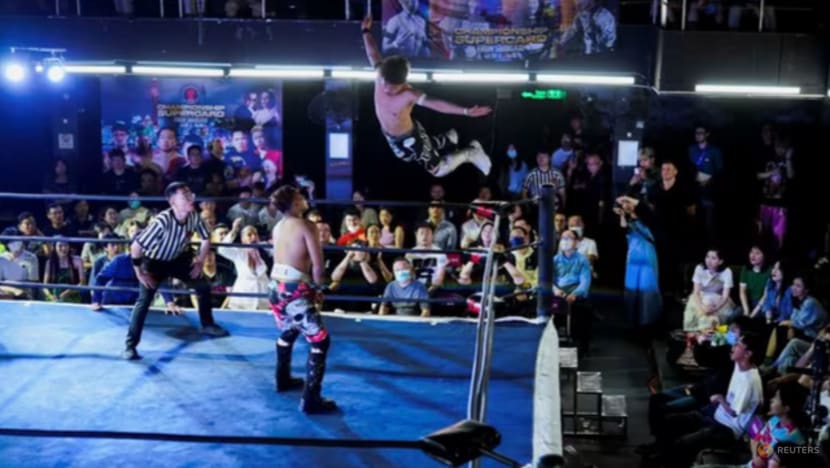China’s pro wrestling scene dealt one-two blow by sluggish economy, lack of support
In an economy looking for new ways to get people spending, the sport’s toughest match might not be in the ring but in consumers' wallets, say observers.

Pro wrestlers battle at China's professional league, Middle Kingdom Wrestling (MKW), in Shanghai, China Jun 6, 2023. (File Photo: REUTERS/Aly Song)

This audio is generated by an AI tool.
BEIJING: In an event space on the fringes of Beijing, two heavyset wrestlers in spandex and masks stare each other down in the middle of a ring.
They spring off the ropes with surprising agility, poised to strike.
A third figure, clad in a traditional Chinese gown, storms onto the squared circle. With swift, kungfu-style power kicks, he sends both fighters crashing onto the mat with thunderous thuds that echo around the arena.
"This is awesome! This is awesome!" the crowd roars in English.
While the venue sold out all of its almost 400 seats, the overall number of Chinese pro wrestling spectators is a far cry from what it once was, with its standing ticket sales far below expectations.
A few years ago, Middle Kingdom Wrestling (MKW), one of China’s few homegrown wrestling promoters, was riding a wave of momentum. Viewership was increasing – its roster of pro wrestlers sold out shows and profited from the sale of merchandise.
But since the COVID-19 pandemic hit, it has struggled to recreate the buzz.
As China’s economic slowdown continues to bite, its ticketed shows – which used to be held once every two months – are now organised just twice a year.
“We kind of had to slow down a bit and try to find opportunities. The economy continues to be sluggish for a lot of industries,” said Adrian Gomez, president of the organisation.
Its shows are infused with a distinct local flair – wrestlers don gear with Chinese embroidery while traditional music blares from the speakers.
A ticket at the front row costs about US$70, while the cheapest is priced at around US$26.
Hardcore fans said they are willing to pay the relatively steep price, given that the live atmosphere at such events is electrifying and "incomparable" to watching on a screen. Some said they would even travel from other cities just for the experience.
"I don’t think it’s very expensive. Here, I can experience the live atmosphere, see some of our top fighters, and also some of our top-tier pro wrestlers. It’s totally worth it,” a ticket holder told CNA.
MKW also live streams its shows for free, which typically attract several thousand views.
UNTAPPED POTENTIAL
In January, Chinese authorities relaxed rules for staging large-scale commercial performances as part of efforts to spur consumption.
But pro wrestling is still struggling to carve out its audience in the country as debate persists over whether it is a violent sport or staged spectacle.
The community lament a lack of official support, recognition and understanding of the sport.
The scene’s largely underground following is a world of difference from its far more glitzy and well-known counterpart – the World Wrestling Entertainment (WWE) in the United States.
WWE’s flagship Raw programme still sees about 1.7 million viewers in America per episode, and made its Netflix debut in January with 4.9 million global views.
Industry players said they believe there is enormous untapped potential for pro wrestling in China, the world’s second most populous nation. They added that the sector just needs a breakout star to give the sport a fighting chance.
“The Chinese wrestling industry is still quite new and the main thing is that we need to cultivate an environment where it’s going to allow a Chinese wrestler to break out. That is what’s going to build up the scene,” said MKW’s Gomez.

For now, the sport remains a niche pursuit powered by passion, not profit.
“I was a full-time professional wrestler for a while, but it was only for a period of time. Most wrestlers have to work other jobs to make money,” said a Chinese pro wrestler known as The Slam.
“Wrestling can only be a side hustle – there are some who do it full-time, but they’re the very few.”
Still, there are hopes that pro wrestling could gain ground.
In southern China's Guangdong province, where WWE used to air on cable television, a restaurant went viral on Chinese social media last year for featuring its own wrestling ring.
MKW, which celebrated its 10th anniversary this year, said the next step is to expand domestically beyond traditional fan hubs like Guangdong and Shanghai, into new markets like Beijing.
"Beijing hasn't had a wrestling show in over 10 years, so that was a very calculated decision," Gomez said of the promoter's organising of its recent event in the Chinese capital.
"If we go to Beijing, we've got to make sure that's it's the right time, that we have the right resources and that we do it right."
He added that featuring international stars can also help boost the profile for local talents.
“As long as it’s marketed right, and the right angle is there, I think people are willing to watch."

















